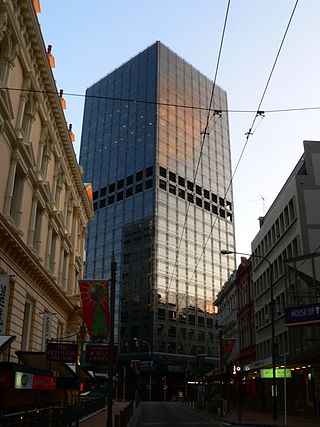
ANZ Bank New Zealand Limited is a New Zealand banking and financial services company, which operates as a subsidiary of Australia and New Zealand Banking Group Limited of Australia. ANZ is one of New Zealand's big four banks, and is the largest bank in New Zealand with approximately 30% of market share as of March 2021.

ASB Bank Limited, commonly stylised as ASB, is a bank owned by Commonwealth Bank of Australia, operating in New Zealand. It provides a range of financial services including retail, business and rural banking, funds management, as well as insurance through its Sovereign Limited subsidiary, and investment and securities services through its ASB Group Investments and ASB Securities divisions. ASB also operated BankDirect, a branchless banking service that provided service via phone, Internet, EFTPOS and ATMs only.

Lambton Quay is the heart of the central business district of Wellington, the capital city of New Zealand.

ANZ Fiji is the largest bank in Fiji and has about a 40% market share. ANZ Fiji currently operates 13 branches country-wide.
Sir Ralph Norris is an Australasian business leader, knighted for services to New Zealand business in 2009. He transitioned from CIO to CEO, leading business and culture transformations across different industries. Currently the chairman of Craigs Investment Partners, Norris has held several chair and board roles and was previously CEO of ASB Bank (1991–2001), Air New Zealand (2002–2005) and the Commonwealth Bank Group (2005–2011). While at ASB, Norris was instrumental in the launch of New Zealand’s first automatic teller machines and Eftpos technology. He is known for his business turnaround acumen and 'no surprises' approach, demonstrating a practical and down-to-earth style. He led the banking industry globally in moving executive long-term incentives (LTIs) away from purely financial performance, linking them for the first time to customer satisfaction. Norris is a honorary Fellow of the Institute of IT Professionals, an ambassador of the Australian Indigenous Education Foundation, was awarded an Honorary Doctorate of Business by the University of New South Wales in 2012, and was inducted into the New Zealand Business Hall of Fame in 2014. He is a strong advocate of tertiary education.
The Big Four is the colloquial name given to the four main banks in several countries where the banking industry is dominated by just four institutions and where the phrase has thus gained relevance. Some countries include more or fewer institutions in such rankings, leading to other names such as Big Three, Big Five, or Big Six.

The Aon Centre is a commercial office building at 1 Willis Street in Wellington, New Zealand, formerly named the BNZ Centre then the State Insurance Building. When completed in 1984, it was the tallest building in New Zealand, overtaking the 87m Quay Tower in Auckland. It is notable for its strong, square, black form, in late International Style modernism, and for a trade dispute which delayed the construction by a decade. It remained the tallest building in New Zealand until 1986, when the 106 meter BNZ Tower opened in Auckland, and is currently the second tallest building in Wellington after the Majestic Centre.
Countrywide Banking Corporation limited was a retail bank operating throughout New Zealand until 1998 when it was acquired by the National Bank of New Zealand. It was created from Countrywide Building Society, which itself emerged from the original Auckland Co-operative Terminating Building Society created in March 1897.

Westpac Banking Corporation, known simply as Westpac, is an Australian multinational banking and financial services company headquartered at Westpac Place in Sydney.

The Old Bank Arcade is a retail and office complex on a corner site at Lambton Quay, Wellington, New Zealand.
Heartland Bank is a New Zealand owned bank that was created in 2011 through the merging of four financial organisations. Heartland was granted its bank registration by the Reserve Bank of New Zealand in 2012. It specialises in motor vehicle loans, reverse mortgages, small business finance, livestock finance, savings, investments and deposits.

Plimmer Towers is a high-rise office, hotel and car park complex in central Wellington, New Zealand, named after John Plimmer, active in business and politics during Wellington's early years. The office building is 84m high and has 31 storeys. It was the tallest building in New Zealand until Auckland's Quay Tower opened in 1981.
KlickEx is a New Zealand fintech company that provides a payment system for domestic, low value electronic foreign exchange transactions to Polynesian countries using a smart market retail system.

The 2016 Kaikōura earthquake was a 7.8 earthquake in the South Island of New Zealand that occurred two minutes after midnight on 14 November 2016 NZDT. Ruptures occurred on multiple faults and the earthquake has been described as the "most complex earthquake ever studied". It has been subsequently modelled as having a megathrust component set off by an adjacent rupture on the Humps Fault. It was also the second largest earthquake since European settlement.
Andrew Thorburn is an Australian-based businessman. Andrew Thorburn is a former CEO of Bank of NZ (BNZ), and also of National Australia Bank (NAB).

The global COVID-19 pandemic had a significant impact on the New Zealand economy. New Zealand has a mixed economy – a free market with some state ownership and control. In mid-March 2020, the New Zealand Government imposed a four-tier alert level system, which placed much of the country's economy into lockdown with the exception of "essential services" such as supermarkets. Due to the success of the Government's elimination strategy, lockdown restrictions on various economic activities were progressively lifted between April and June 2020.
Bendon Group is a New Zealand lingerie, underwear and sleepwear company. It includes the women's brands Bendon, Me by Bendon, Pleasure State, Lovable and Hickory, the fuller cup size brand Fayreform, and the men's brands Bendon Man and Davenport.

BNZ Harbour Quays was a large, award-winning office building on the waterfront in Wellington, New Zealand. It was built in 2009 and leased to the Bank of New Zealand, but suffered earthquake damage in the 2013 Seddon earthquake and the 2016 Kaikōura earthquake. The building was demolished in 2019.














